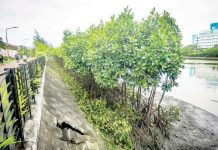TUESDAY last week, April 3 to be exact, moi was “hijacked” by good friend and “brother”, international designer Edgardo Lopez Suelo, to attend with him a meeting/forum of stakeholders concerned with the ongoing construction of the “Esplanade” along Iloilo River.
“Hijacked” (pun intended) indeed as moi has already missed two meetings organized and financed by Edgardo on an advocacy he is most passionate about…the plight of the mangroves along Iloilo River.
Take note that moi was an animal welfare advocate for two decades, so from saving fauna perhaps it’s high time to save the flora, and being an advocate to decriminalize and legalize marijuana saving another plant works just fine.
Moi has always been Edgar’s de facto consultant on just about anything, no not his “spiritual adviser” but would love to be his personal fitness trainer (again, pun intended).
If you noticed his understated foray into public affairs i.e. politics, then you need not look further.
The man is blessed and it just seems natural for him to give back. He has fed the hungry and helped the sick so it would not be a surprise if he would focus his efforts and resources to save mangroves and save the environment.
Meanwhile, the meeting was at the regional office of the Department of Public Works and Highways or DPWH, the main proponent of the Iloilo Esplanade Project, the star of the ambitious Iloilo Development Project.
There are to be nine esplanades all along the Iloilo River which is actually an arm of the sea and not a true river in the strictest sense of the word as it has a high and low tide and is quite salty to brackish.
Esplanades 1 and 2 are already done and are the crown jewels of Iloilo River, the cleanest urban river in the Philippines. Simultaneously, constructions of Esplanades from 3 to 9 are ongoing and that’s where our story begins.
Somewhere along the Esplanade 3 a dike was constructed effectively killing a huge patch of fully grown mangroves, mostly 20 to 30 years old.
And also along the path of Esplanade 6 another smaller patch of fully grown mangroves will be put to axe.
And to conservationists, environmentalists and advocates of plant welfare, this is a big NO. We cannot put aestheticism or to use dismissed former World Mayor No. 5 Jed Mabilog’s favorite term, “beautification project”, over a living plant or tree.
The meeting at the DPWH was attended by officials of the Department of Environment and Natural Resources or DENR, the City Environment and Natural Resources Officer or CENRO, City Tourism Office, private contractors of the Esplanade Project, the academe, media and of course officials of DPWH.
The meeting was organized by Presidential Assistant or Consultant for Region 6 Jane Javellana with a little persuasion (pun intended) from Edgar Suelo.
Now you may ask why all that fuss over trees growing on the banks of Iloilo River that the natives seem to take for granted. What’s so important about mangroves?
Here are excerpts from a report on the World Economic Forum of the United Nations:
Better protecting the world’s fast-disappearing mangroves could have big economic, social and environmental benefits, experts said at the UN climate talks in Lima.
Besides protecting shorelines from extreme weather and providing fish a safe place to breed, mangroves could play a big role in trapping climate-changing carbon emissions, something that has so far been largely overlooked, they said.
The world needs to ensure that, at both national and international levels, “mangroves have a place in REDD+ (Reducing Emissions from Deforestation and Forest Degradation) strategies and other low carbon development strategies such as National Appropriate Mitigation Actions (NAMAs),” said Achim Steiner, the (UNEP) UN Environment Programme’s executive director.
Tim Christophersen, a forest and climate change expert with UNEP, told the Thomson Reuters Foundation that protecting and conserving mangroves is crucial for the climate resilience of the world’s coastlines as they face threats such as rising sea level, increasingly frequent and powerful storms and saltwater intrusion into drinking water.
The world needs to ensure that, at both national and international levels, “mangroves have a place in REDD+ (Reducing Emissions from Deforestation and Forest Degradation) strategies and other low carbon development strategies such as National Appropriate Mitigation Actions (NAMAs),” said Achim Steiner, the U.N. Environment Programme’s executive director.
“The management of coastal wetlands is replete with numerous benefits including fisheries production and shoreline protection which promote adaptation in coastal communities,” said Stephen Crook, climate change director at the California-based environmental science and planning firm ESA.
Furthermore, mangroves form the foundation of a highly productive and biologically rich ecosystem that is home to a spectacular range of species of birds, mammals, invertebrates and fish which help to support people through fisheries, tourism and cultural heritage.
And take note, out of 33 species of mangroves in the Philippines, 23 are found in the Iloilo River.
And that’s what the fuss is all about; incidentally, the meeting went well, ably handled by the moderator Presidential Assistant or Consultant for Region 6 Jane Javellana, as tangible compromises and efforts to save the mangroves were agreed upon.
Not bad for a former “balloon artist”…
And from the PowerPoint presentations, the self-serving statements and comments, relevant questions and mediocre lunch, this came out: The Iloilo Nature Conservation Society, the brainchild of Architect and Urban Planning Expert Manuel Tingzon and Edgardo Suelo, a gathering of artists, academe, professionals, conservationists, environmentalists and Nature Advocates.
The Society aims to launch a massive information and education campaign or IEC to educate the natives on nature conservation and give voice to the much maligned and abused mangrove. (brotherlouie16@gmail.com/PN)





